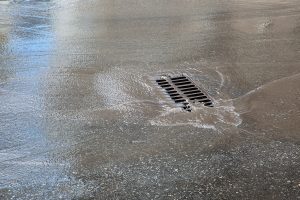 Although it’s true that “April showers bring May flowers,” the spring season also significantly increases the possibility of stormwater runoff and pollution. Stormwater runoff occurs when snow melts and rain falls onto nonabsorbent surfaces, creating a body of water that picks up debris, dirt, and other pollutants before flowing into a sewer or natural body of water.
Although it’s true that “April showers bring May flowers,” the spring season also significantly increases the possibility of stormwater runoff and pollution. Stormwater runoff occurs when snow melts and rain falls onto nonabsorbent surfaces, creating a body of water that picks up debris, dirt, and other pollutants before flowing into a sewer or natural body of water.
Pollutants collected in runoff can adversely affect the environment, and they can also enter into groundwater systems used for drinking. Once there, pollutants can be almost impossible to remove. Runoff carries pollutants ranging from parking lot oils and greases to hazardous materials from construction sites or industrial facilities.
To ensure they’re doing their parts to minimize stormwater pollution, project managers should establish a Stormwater Pollution Prevention Plan for each site and keep each stocked with the proper prevention equipment.
Plan ahead and minimize pollution

According to the Environmental Protection Agency’s (EPA) stormwater pollution prevention plan guide, the Clean Water Act requires operators with “discharges associated with industrial activity” to maintain water supply integrity. Therefore, they must establish Stormwater Pollution Prevention Plans (SWPPPs) to mitigate possible environmental damage. An SWPPP is a document that identifies industrial activities at each site, including any structural control practices, which the site operator will implement to prevent pollutants from making their way into bodies of water via stormwater runoff.
SWPPP
The EPA requires site-specific SWPPPs. These written documents identify possible sources of pollution, control measures, and quick-response methods. Creating the most effective SWPPP requires several key steps:
- Assess all potential stormwater pollution sources.
- Select appropriate control measures that minimize pollutant discharge.
- Form a pollution prevention team of qualified employees to educate fellow facility personnel on how to implement the SWPPP.
- Develop procedures for conducting required inspection and monitoring activities.
After identifying all potential pollution sources, project managers can choose stormwater protection products such as storm drain covers and drain filter inserts to avoid stormwater runoff contamination. Used to block drains, grates, and manholes, these can help site managers avoid and remove runoff without posing pollution risks. As an alternative solution, managers can direct runoff away from potential containments using spill containment berm dikes. If a storm drain or basin already contains runoff, site managers can use catch basin oil skimmers to continuously absorb hydrocarbons such as diesel, oil, and hydraulic oil while repelling water.
With pollution prevention devices in place, educated employees, and a plan for avoiding future pollution, project managers can be well-prepared for protecting the environment — and protecting themselves against EPA enforcement actions.
Ready to set up your first autoshipment of stormwater products so you’re prepared for spring? Contact our sales team at sales@absorbentsonline.com or (800) 869-9633.